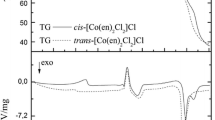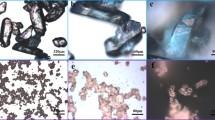Abstract
The thermal dehydration of copper(II) acetate hydrate has been studied between 353 and 406 K, over a range of humidities. The dehydration is controlled by nucleation-and-growth kinetics at low temperatures, with an activation energy of 154 kJ·mol−1, which changes to contracting-disc kinetics at higher temperatures with a lower activation energy of 76 kJ·mol−1. Frequency factors have also been derived; the value for the high temperature process is low (107s−1) and that for the low temperature step is high (1017s−1). Optical microscopy has been used to clarify the bulk kinetics; there is evidence for a reactive layer at the surface of the decomposing solid.
Zusammenfassung
Im Intervall 353–406 K und bei verschiedener Feuchte wurde die thermische Dehydration von Kupfer(II)-acetate-Hydrat untersucht. Bei niedrigen Temperaturen wird die Dehydratation durch eine Kernbildungs- und Kernwachstumskinetik mit einer Aktivierungsenergie von 154 kJ/mol kontrolliert, was bei höheren Temperaturen in eine Kinetik kontraktierender Scheiben mit einer niedrigeren Aktivierungsenergie von 76 kJ/mol übergeht. Die Frequenzfaktoren wurden ebenfalls ermittelt; der Wert für den Prozeß bei höherer Temperatur ist niedrig (107s−1) und der für den Schritt bei niedrigerer Temperatur groß (1017 s−1). Zur Klärung der Volumen-Kinetik wurde optische Mikroskopie angewendet; es gibt Beweise für eine reaktive Schicht an der Oberfläche des sich zersetzenden Feststoffes.
Similar content being viewed by others
References
Z. Goffer, Archeological Chemistry, Wiley, 1980, p. 260.
A. F. Wells, Structural Inorganic Chemistry, 3rd Edition, O.U.P., 1962, p. 392.
H. R. Oswald and W. Feitnecht, Helv. Chim. Acta,44 (1961) 272. W. Feitnecht, ‘Essays in Coordination Chemistry’, Ed. W. Schneider, G. Andereeg and R. Gut, Birkhauser Verlag, Basel, 1964, p. 84.
R. Walker, J. Chem. Ed., 57 (1980) 277.
N. Koga and H. Tanaka, Solid State Ionics,44 (1990) 1.
H. Tanaka and N. Koga, Thermochim. Acta,173 (1990) 53.
J. F. Young, J. Appl. Chem.,17 (1967) 24.
J. H. Sharp, G. W. Brindley and B. N. N. Achar, J. Amer. Ceram. Soc.49 (1966) 379.
H. F. Cordes, J. Phys. Chem.,72 (1968) 2185.
A. K. Galwey, Adv. Cat.,26 (1977) 247.
A. K. Galwey and M. E. Brown, J. Catal., 60 (1979) 335.
M. C. Ball and M. J. Casson, J. Thermal Anal.,28 (1983) 371.
W. E. Garner (Ed.), Chemistry of the Solid State, Butterworth, London, 1955, Ch. 8.
A. K. Galwey, R. Spinicci and G. G. T. Guarini, Proc. Roy. Soc. London, A378 (1981) 477.
J. Walker, Scientific American255 (1986) 178.
Author information
Authors and Affiliations
Additional information
In celebration of the 60th birthday of Dr Andrew K. Galwey
Rights and permissions
About this article
Cite this article
Ball, M.C., Portwood, L. The dehydration of copper(II) acetate monohydrate. Journal of Thermal Analysis 41, 347–356 (1994). https://doi.org/10.1007/BF02549320
Issue Date:
DOI: https://doi.org/10.1007/BF02549320




